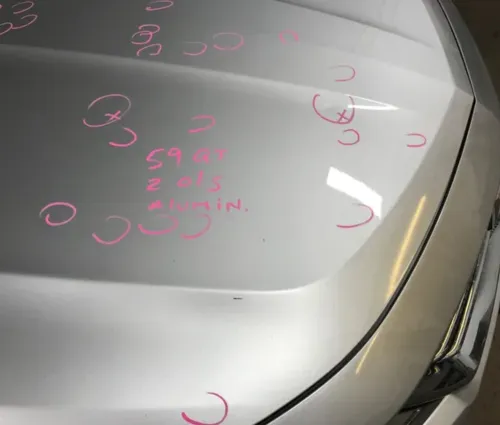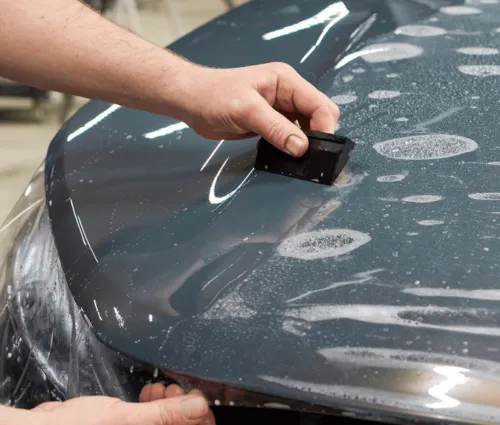Hail Repair
PPF, Wraps, and Hail: What You Should Know

FSDAVCFEBFEVSDDVFSD

FSDAVCFEBFEVSDDVFSD

FSDAVCFEBFEVSDDVFSD
PPF vs hail dents: reality check

Paint protection film and vinyl wraps shield paint from chips, abrasion, and UV, but they do not stiffen a panel. During a hail strike, the metal flexes; thin polymer on top cannot change the panel’s geometry. Think of it like a phone screen protector: scratches saved, dents unaffected.
Typical PPF measures 6–10 mils, engineered to self-heal light marring and absorb minor energy, not blunt an impact from ice. Wrap vinyl is often thinner. Both reduce paint damage when debris glances off, yet hailstones deliver localized force that passes through film and still creates a dent anyway.

How hail impacts wrapped vehicles
On a wrapped or PPF-equipped car, hail leaves two traces: the dent in the metal and whatever mark the ice makes on the film. Because films are sacrificial, they often scuff instead of chipping paint. The metal below, however, still dimples. After a storm, you may see smooth dents with intact film—classic vinyl wrap hail damage.
Where the stone edges strike, the film can micro-tear or bruise, especially along tensioned curves or near cut lines. Adhesive may turn cloudy temporarily from compression. Those cosmetic marks are fixable by replacing sections of film, but they don’t indicate failure of the underlying clearcoat when the installation was done correctly. Panels remain structurally sound underneath.
Severe hail can still compromise edges. Impacts that fold a panel’s lip or crease near a wrapped seam may cause minor lifting or dirt intrusion. That is a film issue, not a paint catastrophe. The key takeaway: films preserve appearance, but hail repair still targets metal. That’s where skilled PDR restores shape cleanly without repainting panels.

PDR with paint protection film?
Yes—with caveats. When panels are wrapped in PPF, technicians avoid drilling and prefer non-marring tools. If a dent is accessible from behind, pushing with rods through factory openings leaves the film undisturbed. On exterior-only access, gentle glue pulling may work on robust PPF, but the bond must be tuned to avoid delaminating edges or stretching patterns. Heat control and slow lift are essential.
Vinyl color-change wraps are thinner and more sensitive. On creased dents, or where the wrap is aging, best practice is to remove and later re-install the affected section after PDR. This prevents whitening, adhesive shear, or surface distortion. Dentex Midwest documents film condition beforehand and coordinates reapplication so you leave with both corrected panels and tidy visuals. Fitment checks and seam alignment included.

When dents sit directly beneath a film seam, badge, or edge, technicians will usually lift or replace that section before repair. Removal allows precise metal work and clean finishing, especially on aluminum hoods where feedback is subtle. Films are mapped, cut, and stored or discarded depending on age. Fresh, healthy PPF can sometimes be saved; brittle vinyl typically gets new material for best results. Color edges and sensors are protected during handling.
After PDR, film technicians prep the panels with isopropyl mix, align patterns, and squeegee out moisture under controlled heat. This step eliminates any temporary hazing from the storm and ensures tight edges. For partial sections, the new piece is overlapped or butt-seamed per template guidelines. Your goal is a factory-like appearance: corrected metal geometry under a smooth, clear, bubble-free layer. Cure times vary by film brand and shop environmental conditions in Missouri.
Film replacement insurance in Missouri
Hail claims primarily cover the vehicle, not aftermarket add-ons—yet many policies reimburse protective film that was damaged by the covered event. The key is documentation. Before repairs begin, Dentex Midwest photographs dents and any film scuffs, lists sections requiring removal, and notes age. This creates a clear record for your adjuster. Faster approvals and accurate allowances follow.
If your wrap is cosmetic, insurers may classify replacement as part of returning the vehicle to pre-loss condition when the film is torn, lifted, or cannot be reused. If the film merely scuffed, they may deny film replacement but still authorize PDR. Outcomes vary by carrier and policy endorsements, so expectations should be set early and documented.
Deductibles still apply, and some comprehensive policies include limits on aftermarket accessories. Discuss whether the claim will list film as a separate line item, and whether coverage includes reinstallation labor and materials. Dentex Midwest coordinates with your adjuster and, upon request, provides estimates with film part numbers, square footage, and labor hours for clarity from the start.
Prevention tips before the next storm
Use covered parking whenever possible. At home, prioritize garage; at work, choose a deck or carport. If a storm approaches, move the car under shelter. Even brief cover during peak cells can reduce impact energy and prevent dents.
Pack a hail blanket or moving pads in spring. If you’re caught outside, drape and secure them with straps—avoiding wiper arms and sensors. Soft covers don’t stop dents, but they soften blows and protect paint from ice edges.
Use weather apps with hail alerts at home and work. Many give lead time. When storms target your area, reschedule errands or pull into a gas-station canopy. Prevention beats paying for multi-panel dent repair after a supercell strike.


Remember, films are fantastic for daily wear: sandblasting highways, door scuffs, kids’ bikes, even winter grit. Against hail, they’re a helpful buffer for paint but not a shield for steel or aluminum. If a storm leaves dents, prompt evaluation keeps costs predictable, protects warranties, and shortens cycle time—especially when wrapped sections need coordinated removal and reinstallation. Dentex Midwest streamlines estimates, photographs damage, and sequences PDR with film work so your vehicle looks right the first time.
Post-repair protection and maintenance tips
After dents are removed, decide whether to reapply film in full panels or use strategic sections. Full-panel PPF gives uniform gloss and hides seams; sectioning can be cost-effective on lower-risk areas. On color-change wraps, fresh material is recommended on any panel that was creased, because vinyl memory can show faint witness lines even after careful PDR and heat cycling. Edges should be re-tensioned and post-install bubbles chased within twenty-four hours.
Clean film with pH-neutral soap, microfiber, and a soft wash mitt. Avoid sharp nozzles at edges. For PPF, occasional warm-water rinses help self-healing; light heat guns can relax minor swirls—used carefully. For vinyl, skip abrasive polishes and petroleum solvents. Quality ceramic coatings on top of film reduce grime adhesion and make bug removal easier without increasing dent resistance claims or affecting warranty terms. Regular inspections catch lifted edges early too.
Schedule a seasonal check before peak hail months. We assess panel access points, verify headliner clearance for tooling, and note where film edges overlap body seams—useful during future PDR. We also refresh your storm-prep plan and app alerts. With proper care, film enhances the finish you just saved, and professional dent repair keeps the underlying metal straight for years. Ask for touch-up appointments after major systems or season changes too.

Dentex Midwest
Professional Hail Repair & PDR
Stay Up-to-date With Our Content
Subscribe to learn more about our mission!
Stay Up-to-date With Our Content
Subscribe to learn more!
Contact Info
Service Hours
Social Media
Home
Services
Service Areas
Blog
About
Contact
Contact Info
Service Hours
Mon - Fri: 8:00 am – 6:00 pm
Saturday: by Appointment
Sunday: Closed
Social Media

Licensed, bonded, & insured